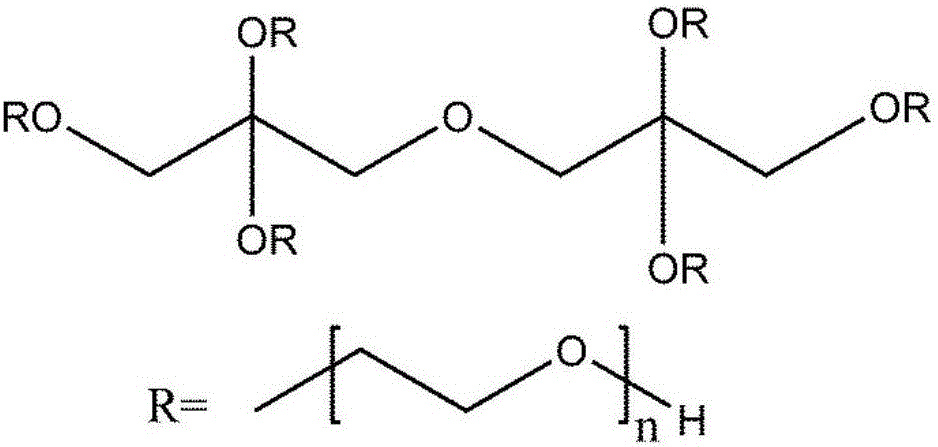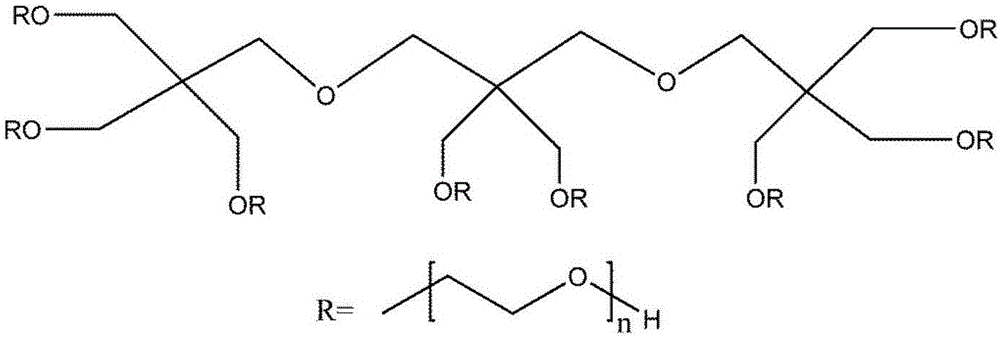Low-swelling biodegradable medical photopolymeric aquagel and preparation method thereof
A biodegradable and photopolymerizable technology, which is applied in the direction of non-active ingredient medical preparations, pharmaceutical formulations, drug delivery, etc., can solve the problems of low strength and large gel swelling ratio, and achieve low swelling ratio and low swelling rate , the effect of avoiding adverse consequences
- Summary
- Abstract
- Description
- Claims
- Application Information
AI Technical Summary
Problems solved by technology
Method used
Image
Examples
Embodiment 1
[0059] (1) Preparation of polyester modified six-arm polyethylene glycol block copolymer
[0060] Put 100g of six-armed polyethylene glycol (molecular weight: 6000) into a vacuum reaction flask, remove water under reduced pressure at 100°C for 2 hours, cool to room temperature, and equilibrate with dry nitrogen, add 11.40g of caprolactone and 0.3g of stannous octoate. After vacuum deoxygenation, the reaction was carried out at a vacuum degree of 10 Pa and a temperature of 115°C for 12 hours. The crude product was dissolved in 50 mL of anhydrous dichloromethane, precipitated with glacial ether, filtered, and vacuum-dried at room temperature to constant weight to obtain a polyester-modified six-arm poly Ethylene glycol block copolymer.
[0061] (2) Preparation of acrylate-terminated polyester modified six-arm polyethylene glycol
[0062] Dissolve 50g of polyester-modified six-arm polyethylene glycol and 4.54g of triethylamine in 30mL of anhydrous dichloromethane, cool down to 0...
Embodiment 2
[0066] (1) Preparation of polyester modified six-arm polyethylene glycol block copolymer
[0067] Put 150g of six-armed polyethylene glycol (molecular weight: 10000) into a vacuum reaction bottle, remove water under reduced pressure at 100°C for 2 hours, cool to room temperature, and equilibrate with dry nitrogen, add 20.52g of caprolactone and 0.4g of stannous octoate. After vacuum deoxygenation, react at a vacuum degree of 20 Pa and a temperature of 125°C for 12 hours. The crude product is dissolved in 80 mL of anhydrous dichloromethane, precipitated with glacial ether, filtered, and vacuum-dried at room temperature to constant weight to obtain a polyester-modified six-arm poly Ethylene glycol block copolymer.
[0068] (2) Preparation of acrylate-terminated polyester modified six-arm polyethylene glycol
[0069] Dissolve 50g of polyester-modified six-arm polyethylene glycol and 5.34g of triethylamine in 25mL of anhydrous dichloromethane, cool down to 0°C, and slowly add 4.7...
Embodiment 3
[0073] (1) Preparation of polyester modified six-arm polyethylene glycol block copolymer
[0074] Put 200g of six-armed polyethylene glycol (molecular weight: 15000) into a vacuum reaction bottle, remove water under reduced pressure at 100°C for 2 hours, cool to room temperature, and equilibrate with dry nitrogen, add 27.36g of caprolactone and 0.35g of stannous octoate. After vacuum deoxygenation, react at a vacuum degree of 10 Pa and a temperature of 135°C for 12 hours. The crude product is dissolved in 120 mL of anhydrous dichloromethane, precipitated with glacial ether, filtered, and vacuum-dried at room temperature to constant weight to obtain a polyester-modified six-arm poly Ethylene glycol block copolymer.
[0075] (2) Preparation of acrylate-terminated polyester modified six-arm polyethylene glycol
[0076] Dissolve 50g of polyester-modified six-arm polyethylene glycol and 3.56g of triethylamine in 25mL of anhydrous dichloromethane, cool down to 0°C, and slowly add 3...
PUM
| Property | Measurement | Unit |
|---|---|---|
| Wavelength | aaaaa | aaaaa |
Abstract
Description
Claims
Application Information
 Login to View More
Login to View More - R&D
- Intellectual Property
- Life Sciences
- Materials
- Tech Scout
- Unparalleled Data Quality
- Higher Quality Content
- 60% Fewer Hallucinations
Browse by: Latest US Patents, China's latest patents, Technical Efficacy Thesaurus, Application Domain, Technology Topic, Popular Technical Reports.
© 2025 PatSnap. All rights reserved.Legal|Privacy policy|Modern Slavery Act Transparency Statement|Sitemap|About US| Contact US: help@patsnap.com



